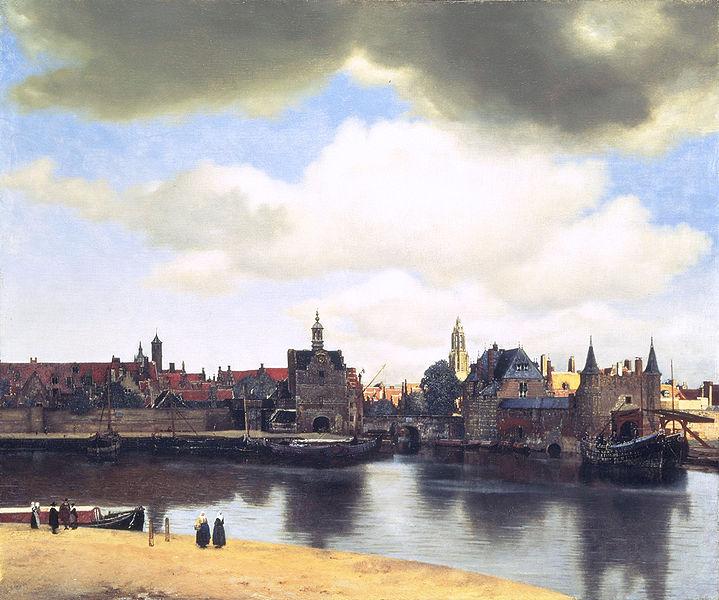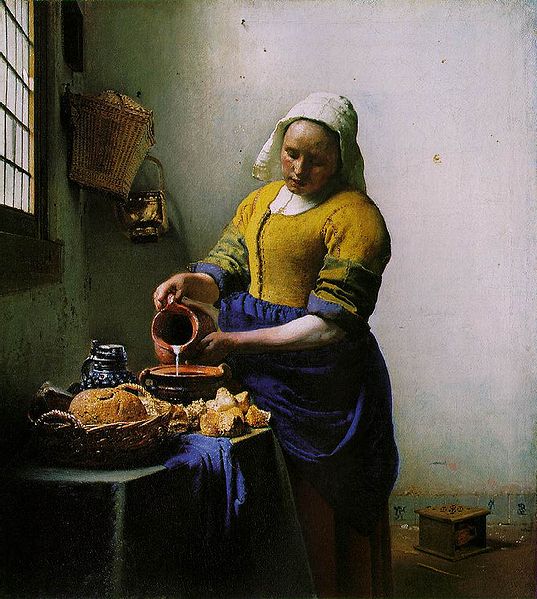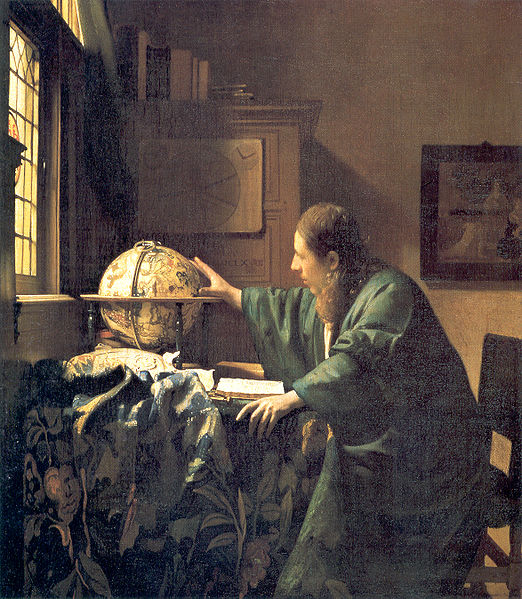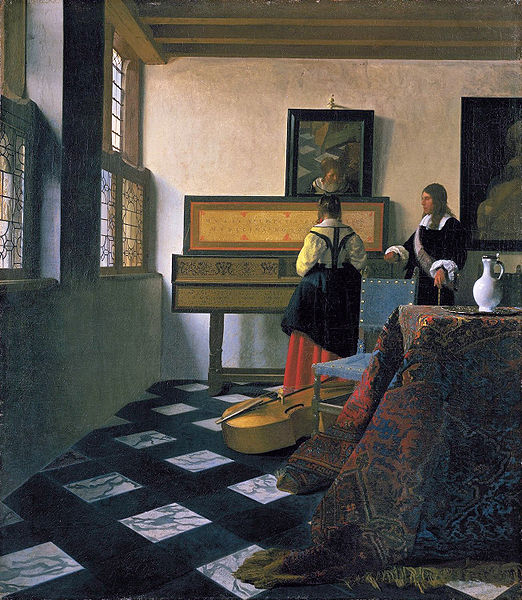<Back to Index>
- Mathematician Karl Theodor Wilhelm Weierstrass, 1815
- Painter Johannes Vermeer, 1632
- Chairman of the Nationalist Government of China Chiang Kai-shek, 1887
PAGE SPONSOR
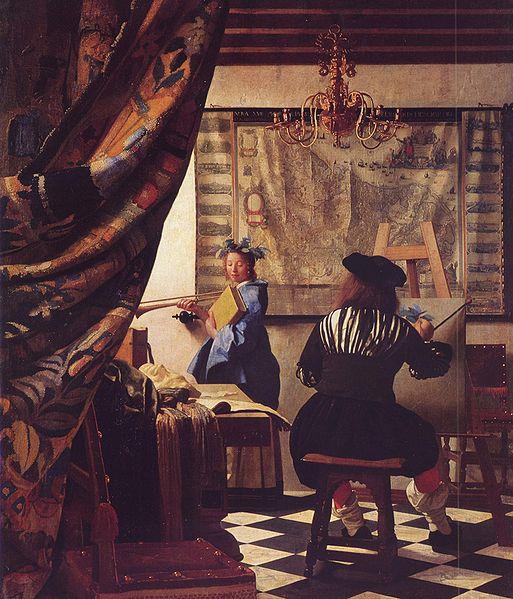
Johannes, Jan or Johan Vermeer (baptized in Delft on 31 October 1632 as Johannis, and buried in the same city under the name Jan on 16 December 1675) was a Dutch Baroque painter who specialized in exquisite, domestic interior scenes of middle class life. Vermeer was a moderately successful provincial genre painter in his lifetime. He seems never to have been particularly wealthy, leaving his wife and children in debt at his death, perhaps because he produced relatively few paintings.
Vermeer worked slowly and with great care, using bright colours and sometimes expensive pigments, with a preference for cornflower blue and yellow. He is particularly renowned for his masterly treatment and use of light in his work. Recognized during his lifetime in Delft and The Hague, his modest celebrity gave way to obscurity after his death; he was barely mentioned in Arnold Houbraken's major source book on 17th century Dutch painting (Grand Theatre of Dutch Painters and Women Artists), and was thus omitted from subsequent surveys of Dutch art for nearly two centuries. In the 19th century Vermeer was rediscovered by Gustav Friedrich Waagen and Théophile Thoré-Bürger, who published an essay attributing sixty-six pictures to him, although only thirty-five paintings are firmly attributed to him today. Since that time Vermeer's reputation has grown, and he is now acknowledged as one of the greatest painters of the Dutch Golden Age.
Relatively little is known about Vermeer's life. He seems to have been exclusively devoted to his art, living out his life in the city of Delft. The only sources of information are some registers, a few official documents and comments by other artists; it was for this reason that Thoré Bürger named him "The Sphinx of Delft".
On 31 October 1632, Johannes was baptized in the Reformed Church. His father, Reijnier Janszoon, was a middle-class worker of silk or caffa (a mixture of silk and cotton or wool). As an apprentice in Amsterdam Reijnier lived in the fashionable Sint Antoniesbreestraat, then a street with many resident painters. In 1615 he married Digna Baltus, and in 1620 Reijnier and his wife had a daughter, who was baptized as Gertruy. In 1625 Reijnier was involved in a fight with a soldier named Willem van Bylandt, who died from his wounds five months later. Around the same time Reijnier started to deal in paintings, but in 1631 he leased an inn called "The Flying Fox". In 1641 he bought a larger inn at the market square, named after the Belgian town "Mechelen". The acquisition of the inn constituted a considerable financial burden. When Vermeer's father died in 1652, Vermeer replaced him as a merchant of paintings.
In 1653 Johannes Reijniersz Vermeer married a Catholic girl named Catharina Bolnes. The blessing took place in a nearby and quiet village Schipluiden. For the groom it was a good match. His mother-in-law, Maria Thins, was significantly wealthier than he, and it was probably she who insisted Vermeer convert to Catholicism before the marriage on 5 April. Some scholars doubt that Vermeer became Catholic, but one of his paintings, The Allegory of Catholic Faith, made between 1670 and 1672, reflects the belief in the Eucharist. Liedtke suggests it was made for a Catholic patron, or for a schuilkerk, a hidden church. At some point the couple moved in with Catharina's mother, who lived in a rather spacious house at Oude Langendijk, almost next to a hidden Jesuit church.
Here Vermeer lived for the rest of his life, producing paintings in the
front room on the second floor. His wife gave birth to 14 children:
four of whom were buried before being baptized, but were registered as
"child of Johan Vermeer". From
wills written by relatives, ten names are known: Maria, Elisabeth,
Cornelia, Aleydis, Beatrix, Johannes, Gertruyd, Franciscus, Catharina, and Ignatius. Quite a few have a name with a religious connotation and it is very likely that the youngest, Ignatius, was named after the founder of the Jesuit order. It
is not certain where Vermeer was apprenticed as a painter, nor with
whom, but it is generally believed that he studied in his home town.
While Vermeer owned some paintings or drawings by Carel Fabritius it was suggested that Fabritius was his teacher. The local authority, Leonaert Bramer, acted as a friend but their style of painting is rather different. Liedtke suggests Vermeer taught himself and had information from one of his father's connections. Some scholars think Vermeer was trained under the Catholic painter Abraham Bloemaert. Vermeer worked in a similar style as some of the Utrecht Carravagists. In Delft Vermeer probably competed with Pieter de Hoogh and Nicolaes Maes who produced genre works in a similar style. On 29 December 1653, Vermeer became a member of the Guild of Saint Luke, a trade association for painters. The guild's records make clear Vermeer did not pay the usual admission fee. It was a year of plague, war and
economic crisis; not only Vermeer's financial circumstances were
difficult. In 1654, the city of Delft suffered the terrible explosion
known as the Delft Thunderclap that destroyed a large section of the city. In 1657 he might have found a patron in the local art collector Pieter van Ruijven,
who lent him some money. In 1662 Vermeer was elected head of the guild
and was reelected in 1663, 1670, and 1671, evidence that he (like
Bramer) was considered an established craftsman among his peers.
Vermeer worked slowly, probably producing three paintings a year, and
on order. When Balthasar de Monconys visited him in 1663 to see some of his work, the diplomat and the two French clergymen who accompanied him were sent to Hendrick van Buyten, a baker. In 1672 a severe economic downturn (the "Year of Disaster") struck the Netherlands, after Louis XIV and a French army invaded the Dutch Republic from the south (known as the Franco-Dutch War). During the Third Anglo-Dutch War an
English fleet and two allied German bishops attacked the country from
the east causing more destruction. Many people panicked; courts,
theaters, shops and schools were closed. Five years passed before
circumstances improved. In the Summer of 1675 Vermeer borrowed money in
Amsterdam, using his mother-in-law as a surety. In December 1675 Vermeer fell into a frenzy and
suddenly died, within a day and a half. Catharina Bolnes attributed her
husband's death to the stress of financial pressures. The collapse of
the art market damaged Vermeer's business as both a painter and an art
dealer. She, having to raise 11 children, asked the High Court to allow
her a break in paying the creditors. The Dutch microscopist Antonie van Leeuwenhoek, who worked for the city council as a surveyor, was appointed trustee. The house, with eight rooms on the first floor, was filled with paintings, drawings, clothes, chairs and beds. In his atelier there were rummage not worthy being itemized,
two chairs, two painter's easels, three palettes, ten canvases, a desk,
an oak pull table and a small wooden cupboard with drawers. Nineteen of Vermeer's paintings were bequeathed to Catharina and her mother, and the widow sold two other paintings to the Hendrick van Buyten in order to pay off quite a debt. Vermeer
had been a respected artist in Delft, but he was almost unknown outside
his home town. The fact that a local patron, Pieter van Ruijven,
purchased much of his output reduced the possibility of his fame
spreading. Vermeer
never had any pupils; his relatively short life, the demands of
separate careers, and his extraordinary precision as a painter all help
to explain his limited oeuvre. Vermeer produced transparent colours by applying paint to the canvas in loosely granular layers, a technique called pointillé (not to be confused with pointillism). No drawings have been positively attributed to Vermeer, and his paintings offer few clues to preparatory methods. David Hockney, among other historians and advocates of the Hockney–Falco thesis, has speculated that Vermeer used a camera obscura to achieve precise positioning in his compositions, and this view seems to be supported by certain light and perspective effects.
The often-discussed sparkling pearly highlights in Vermeer's paintings
have been linked to this possible use of a camera obscura, the
primitive lens of which would produce halation. Exaggerated perspective can be seen in Lady at the Virginals with a Gentleman (London, Royal Collection).
Vermeer's interest in optics is also attested in this work by the
accurately observed mirror reflection above the lady at the virginals. However,
the extent of Vermeer's dependence upon the camera obscura is disputed
by historians. Indeed, other than assumptions made by an analysis of
his style, there is no evidence, either scientific or historical, that
Vermeer ever owned or used such a device. There
is no other seventeenth century artist who early in his career
employed, in the most lavish way, the exorbitantly expensive pigment lapis lazuli, or natural ultramarine. Vermeer not only used this in elements that are naturally of this colour; the earth colours umber and ochre should
be understood as warm light within a painting's strongly-lit interior,
which reflects its multiple colours onto the wall. In this way, he
created a world more perfect than any he had witnessed. This working method most probably was inspired by Vermeer’s understanding of Leonardo’s observations that the surface of every object partakes of the colour of the adjacent object. This
means that no object is ever seen entirely in its natural colour. A
comparable but even more remarkable, yet effectual, use of natural
ultramarine is in The Girl with a Wineglass. The shadows of the red satin dress are underpainted in natural ultramarine, and, owing to this underlying blue paint layer, the red lake and vermilion mixture applied over it acquires a slightly purple, cool and crisp appearance that is most powerful. Even
after Vermeer’s supposed financial breakdown following the so-called
rampjaar (year of disaster) in 1672, he continued to employ natural
ultramarine generously, such as in Lady Seated at a Virginal. This could suggest that Vermeer was supplied with materials by a collector, and would coincide with John Michael Montias’ theory of Pieter van Ruijven being Vermeer’s patron. Vermeer painted mostly domestic interior scenes. His works are largely genre pieces and portraits, with the exception of two cityscapes and two allegories.
His subjects offer a cross-section of seventeenth century Dutch
society, ranging from the portrayal of a simple milkmaid at work, to
the luxury and splendour of rich notables and merchantmen in their
roomy houses. Besides these subjects, religious, poetical, musical, and
scientific comments can also be found in his work. Only three paintings are dated: The Procuress (1656, Dresden, Gemäldegalerie), The Astronomer (1668, Paris, Louvre), and The Geographer (1669, Frankfurt, Städelsches Kunstinstitut). Two pictures are generally accepted as earlier than The Procuress; both are history paintings, painted in a warm palette and in a relatively large format for Vermeer — Christ in the House of Mary and Martha (Edinburgh, National Gallery) and Diana and her Companions (The Hague, Mauritshuis). Vermeer's mother-in-law, Maria Thins, owned Dirck van Baburen's 1622 oil-on-canvas Procuress (or
a copy of it), which appears in the background of two of Vermeer's
paintings. The same subject was also painted by Vermeer. After his own The Procuress almost all of Vermeer's paintings are of contemporary subjects in a smaller
format, with a cooler palette dominated by blues, yellows and greys. It
is to this period that practically all of his surviving works belong.
They are usually domestic interiors with one or two figures lit by a
window on the left. They are characterized by a serene sense of
compositional balance and spatial order, unified by a pearly light.
Mundane domestic or recreational activities become thereby imbued with
a poetic timelessness (e.g. Woman Reading a Letter at an Open Window, Dresden, Gemäldegalerie). To this period also have been allocated Vermeer's two townscapes, View of Delft (The Hague, Mauritshuis) and A Street in Delft (Amsterdam, Rijksmuseum). A
few of his paintings show a certain hardening of manner and these are
generally thought to represent his late works. From this period come The Allegory of Faith (c 1670, New York, Metropolitan Museum) and The Letter (c 1670, Amsterdam, Rijksmuseum).
